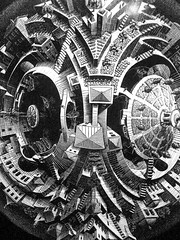Maurits Cornelis Escher (1898 – 1972), usually referred to as M.C. Escher , was a Dutch graphic artist.
He is known for his often mathematically inspired woodcuts, lithographs, and mezzotints. These feature impossible constructions, explorations of infinity, architecture, and tessellations, says Wikipedia.
He was a sickly child, and was placed in a special school at the age of seven and failed the second grade.[3] In 1903, the family moved to Arnhem where he took carpentry and piano lessons until he was thirteen years old.
Though he excelled at drawing, his grades were generally poor. In 1919, Escher attended the Haarlem School of Architecture and Decorative Arts. He briefly studied architecture, but he failed a number of subjects (partly due to a persistent skin infection) and switched to decorative arts.[3]
Escher's first print of an impossible reality was Still Life and Street, 1937. His artistic expression was created from images in his mind, rather than directly from observations and travels to other countries. Well known examples of his work also include Drawing Hands, a work in which two hands are shown, each drawing the other; Sky and Water, in which light plays on shadow to morph the water background behind fish figures into bird figures on a sky background; and Ascending and Descending, in which lines of people ascend and descend stairs in an infinite loop, on a construction which is impossible to build and possible to draw only by taking advantage of quirks of perception and perspective.
He worked primarily in the media of lithographs and woodcuts, though the few mezzotints he made are considered to be masterpieces of the technique. In his graphic art, he portrayed mathematical relationships among shapes, figures and space. Additionally, he explored interlocking figures using black and white to enhance different dimensions. Integrated into his prints were mirror images of cones, spheres, cubes, rings and spirals.
Thursday, April 15, 2010
Subscribe to:
Post Comments (Atom)





No comments:
Post a Comment